The history of Marble Island is still being written. Mysteries abound. Each and every sign of human visitors over the centuries seems to tell a story. Not just one story. Several. Stories that don't fit together. For instance, what exactly happened to the Knight Expedition? Perhaps you will see the evidence or imagine the chain of events in a new way. Perhaps you will solve one of the mysteries...
Return to top of page
Long ago, Inuit families used to travel from place to place, following the caribou. Uanik's family of four, including an old woman, lived near Rankin Inlet. 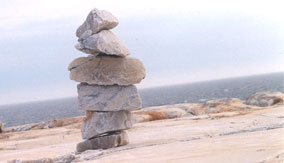 The hunting was good for a few years, but not for long. The family wanted to move to a new land where there there were lots of caribou. The old woman refused to go with them. She said she wanted to live on the ice that looked like an island. So Uanik's family, with sorrow in their hearts, left her behind. Soon after, on a clear day, the old woman sat on a rock on the shore, looking at the big ice. She said to herself, "I wish, how I wish, that ice could turn into an island so I could live there." The hunting was good for a few years, but not for long. The family wanted to move to a new land where there there were lots of caribou. The old woman refused to go with them. She said she wanted to live on the ice that looked like an island. So Uanik's family, with sorrow in their hearts, left her behind. Soon after, on a clear day, the old woman sat on a rock on the shore, looking at the big ice. She said to herself, "I wish, how I wish, that ice could turn into an island so I could live there."
Two years later, Uanik came back to the spot where he had left the old woman, but she wasn't anywhere on the island. He heard her voice say, "Uanik, at last I got my wish; please don't worry anymore." 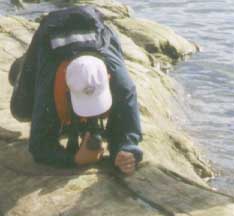 Uanik saw that the ice had turned to marble. Then the old woman told him, "My spirit lives on this marble island." Uanik saw that the ice had turned to marble. Then the old woman told him, "My spirit lives on this marble island."
Now, when the people of Rankin Inlet go to the island, they must crawl a few feet in respect of the old woman's spirit. It is bad luck not to do so! In summer, on a clear day, the island once again looks like an ice island....
There are various Inuit versions of the Marble Island legend. (The one above comes from Leo Sauyalik.) But they all have at least one thing in common: that their great, great ancestors were on location when the strange island of pure white rock first materialized as if by magic.
These legends could be based on fact. The sea floor has been rising out of the sea one inch per year since the melting of the last great ice age. Since the highest point on Marble Island is 2163 inches, the legend may date back to 134 B.C.
Return to top of page
For thousands of years, the Inuit of the region surrounding Marble Island followed the caribou in the cold winter months, then moved to the seacoast for the marine mammals in the spring. Marble Island offered geese, seals and even caribou.
You can witness stone tent frames, kayak rests and other evidence of Inuit camp sites when you explore the hiking trails at the east end of the Island.
Return to top of page
In the early seventeenth century, Europeans Hudson, James and Foxe began exploring what is now called Hudson Bay, seeking a 'northwest passage' to the Orient. In 1631, Foxe, sailing the northwest coast of the Bay, sailed through a pod of forty whales to land on an island 'all of white marble'. He reported its 'great store of Fowle, especially water-fowle' and saw a caribou.
In 1632 the Hudson's Bay Company was granted by England all land, mineral fishing and trading rights to the seven million square kilometre area draining into Hudson Bay. The Company's main interest was fur. It was almost a hundred years before another explorer attempted to find the Northwest Passage through the Bay. His name was James Knight.
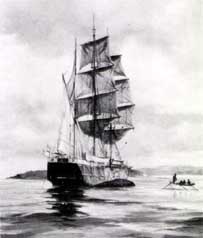 Knight joined the Hudson's Bay Company in the 1670's as a young man. Through his management skills and his military successes in reclaiming Hudson Bay forts lost to the French he became Governor for the Company in 1714, with headquarters at York Fort. He became convinced of a Northwest Passage out of the Bay, leading to a land of precious metals. Returning to England, he gained the backing of the Company to explore for gold and copper. In June, 1719 the Knight Expedition left for the Bay on the frigate Albany and the sloop Discovery. Knight joined the Hudson's Bay Company in the 1670's as a young man. Through his management skills and his military successes in reclaiming Hudson Bay forts lost to the French he became Governor for the Company in 1714, with headquarters at York Fort. He became convinced of a Northwest Passage out of the Bay, leading to a land of precious metals. Returning to England, he gained the backing of the Company to explore for gold and copper. In June, 1719 the Knight Expedition left for the Bay on the frigate Albany and the sloop Discovery.
Three years later a Company trading sloop, sent north from Churchill River to search for copper mines, stopped at the east end of Marble Island. The crew found parts of the two Expedition vessels and an Inuit camp where ship spars had been 'split into tent poles and Tents covered with Sails'. Forty-five years later, in 1767, a Company whaling party discovered Knight's House, a large supply of coal and a number of graves.
The where of the tragedy has been firmly placed on Marble Island. The why has never answered. Competing theories began shortly after the disaster and continue today. The captain of the 1767 whaling party said local Inuit told him some of the crew survived the first winter, but he didn't know whether they were "starv'd with cold or hunger, or destroyed by the Natives." The same captain returned two years later, with Samuel Hearne again as mate. Years later Hearne wrote about finding the skeletons of the last two Expedition survivors on a point overlooking the mainland. He painted the picture of their dashed hopes and suffering. "At length, one of the two died, and the other's strength was so far exhausted, that he fell down and died also, in attempting to dig a grave for his companion."
Investigations of the Knight Expedition have continued in recent times. Expedition '70 brought an underwater team to Marble Island in 1970. More recently (1989-91), Owen Beattie led an archeaological team using modern forensic techniques to investigate the mystery. One result was the book Dead Silence: The Greatest Mystery in Arctic Discovery. Dr. Beattie asks why an experienced arctic explorer would perish with forty men in sight of land and only four days' journey away Hudson Bay Company post? And why did the Hudson's Bay Company make so little effort to rescue them?
Come up with your own answers when you visit the site of Captain Knight's house on the Quartzite Island hiking trail and see the wrecks of the Albany and Discovery on a dive.
Return to top of page
From the 1860's until the end of the 19th century, Marble Island became part of a thriving American whaling industry. The continuing presence of New England whalers led to a high level of co-operation between the whalers and the Inuit of the surrounding lands. This contact had big impact on Inuit life, from settlement patterns to better tools for hunting.
Like the days of the search for the Northwest Passage, Marble Island could -- and did -- become a final resting place for the poorly equipped and the unlucky.
The Hudson's Bay Company tried to hunt bowhead whales at Marble Island every year from 1765 through 1772, without success (although the 1767 trip made important discoveries about the Knight Expedition see above). In 1860, the Chapel brothers from New England made a whaling trip to Roe's Welcome, two hundred kilometres north of Marble Island, returning home with $60,000 worth of whale products. Their success led to several decades of harpoon whaling between Roe's Welcome on the north and Marble Island on the south.
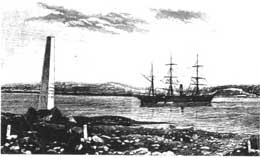 New Englanders overwintered at Marble Island so they could hunt whales from the floe ice when spring arrived. They also aimed to work in harmony with the Inuit. A landlocked harbour at the west end of the Island, now known as Whaler's Harbour, provided excellent protection for overwintering ships. Contact with the Inuit developed into a co-operative trading and working relationship. The Inuit could provide the whalers with meat and other supplies to help them survive the winter; the whalers could provide the Inuit with guns and other tools to improve their hunting chances. During the whaling years some Inuit lived on Marble Island year-round. Sea hunting was good in the summer and the whalers were able to transport Inuit hunters ashore for land hunting at other times of the year. The working relationship developed so far that many Inuks became part of whaling crews. There were even all-Inuit crews hunting whales in the summer in boats left behind by the New England whalers for that purpose. New Englanders overwintered at Marble Island so they could hunt whales from the floe ice when spring arrived. They also aimed to work in harmony with the Inuit. A landlocked harbour at the west end of the Island, now known as Whaler's Harbour, provided excellent protection for overwintering ships. Contact with the Inuit developed into a co-operative trading and working relationship. The Inuit could provide the whalers with meat and other supplies to help them survive the winter; the whalers could provide the Inuit with guns and other tools to improve their hunting chances. During the whaling years some Inuit lived on Marble Island year-round. Sea hunting was good in the summer and the whalers were able to transport Inuit hunters ashore for land hunting at other times of the year. The working relationship developed so far that many Inuks became part of whaling crews. There were even all-Inuit crews hunting whales in the summer in boats left behind by the New England whalers for that purpose.
The New England whalers suffered casualties in the early years at Marble Island, as the two dozen graves on Deadman's Island testify. More than half the graves come from the winter of 1873. Fall storms wrecked one of the three whaling ships and cracked another in half, leading to lost provisions, overcrowding and greater exposure to cold. Scurvy was the specific cause of death for fifteen harpooners. Many condemned themselves by refusing to eat fox meat.
By 1887, the number of whales off Marble Island had declined considerably. The year marked the last winter whalers overwintered there. By 1905, whaling had disappeared from Hudson Bay altogether.
You can still see much evidence of the whaling years on the Whaler's Trail. When you hike beside the Whalers' Harbour you can see the 1873 wreck of the whaling bark Orray Taft at low tide in calm water. You can visit the graves of four of her crew on Deadman's Island. Their resting places are part of a line of graves from that tragic winter. The whalers also left behind some evidence that Marble Island could become a lively winter community. You can see the stone foundation of a theatre, built in the fall of 1864, for comic sketches and even a three-act drama that winter.
Return to top of page
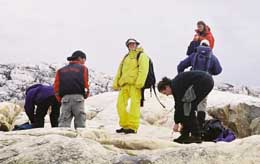 Today Marble Island is part of the Kivalliq District of the recently established Canadian Territory of Nunavut. Because of its cultural importance to the Inuit people of the region, the Island was the only "Special Inuit Possession" designated in the Nunavut Land Claim that formed the Territory. Today Marble Island is part of the Kivalliq District of the recently established Canadian Territory of Nunavut. Because of its cultural importance to the Inuit people of the region, the Island was the only "Special Inuit Possession" designated in the Nunavut Land Claim that formed the Territory.
Its unusal geology, striking geology and place in exploration and whaling history have made it an attracting destination for adventurers, eco-tourists, history buffs and divers.
Plan your own adventure to Marble Island.
The next stop on this web site tour is a glimpse of Marble Island's startling geology. 
|


 The hunting was good for a few years, but not for long. The family wanted to move to a new land where there there were lots of caribou. The old woman refused to go with them. She said she wanted to live on the ice that looked like an island. So Uanik's family, with sorrow in their hearts, left her behind. Soon after, on a clear day, the old woman sat on a rock on the shore, looking at the big ice. She said to herself, "I wish, how I wish, that ice could turn into an island so I could live there."
The hunting was good for a few years, but not for long. The family wanted to move to a new land where there there were lots of caribou. The old woman refused to go with them. She said she wanted to live on the ice that looked like an island. So Uanik's family, with sorrow in their hearts, left her behind. Soon after, on a clear day, the old woman sat on a rock on the shore, looking at the big ice. She said to herself, "I wish, how I wish, that ice could turn into an island so I could live there." Uanik saw that the ice had turned to marble. Then the old woman told him, "My spirit lives on this marble island."
Uanik saw that the ice had turned to marble. Then the old woman told him, "My spirit lives on this marble island." Knight joined the Hudson's Bay Company in the 1670's as a young man. Through his management skills and his military successes in reclaiming Hudson Bay forts lost to the French he became Governor for the Company in 1714, with headquarters at York Fort. He became convinced of a Northwest Passage out of the Bay, leading to a land of precious metals. Returning to England, he gained the backing of the Company to explore for gold and copper. In June, 1719 the Knight Expedition left for the Bay on the frigate Albany and the sloop Discovery.
Knight joined the Hudson's Bay Company in the 1670's as a young man. Through his management skills and his military successes in reclaiming Hudson Bay forts lost to the French he became Governor for the Company in 1714, with headquarters at York Fort. He became convinced of a Northwest Passage out of the Bay, leading to a land of precious metals. Returning to England, he gained the backing of the Company to explore for gold and copper. In June, 1719 the Knight Expedition left for the Bay on the frigate Albany and the sloop Discovery. New Englanders overwintered at Marble Island so they could hunt whales from the floe ice when spring arrived. They also aimed to work in harmony with the Inuit. A landlocked harbour at the west end of the Island, now known as Whaler's Harbour, provided excellent protection for overwintering ships. Contact with the Inuit developed into a co-operative trading and working relationship. The Inuit could provide the whalers with meat and other supplies to help them survive the winter; the whalers could provide the Inuit with guns and other tools to improve their hunting chances. During the whaling years some Inuit lived on Marble Island year-round. Sea hunting was good in the summer and the whalers were able to transport Inuit hunters ashore for land hunting at other times of the year. The working relationship developed so far that many Inuks became part of whaling crews. There were even all-Inuit crews hunting whales in the summer in boats left behind by the New England whalers for that purpose.
New Englanders overwintered at Marble Island so they could hunt whales from the floe ice when spring arrived. They also aimed to work in harmony with the Inuit. A landlocked harbour at the west end of the Island, now known as Whaler's Harbour, provided excellent protection for overwintering ships. Contact with the Inuit developed into a co-operative trading and working relationship. The Inuit could provide the whalers with meat and other supplies to help them survive the winter; the whalers could provide the Inuit with guns and other tools to improve their hunting chances. During the whaling years some Inuit lived on Marble Island year-round. Sea hunting was good in the summer and the whalers were able to transport Inuit hunters ashore for land hunting at other times of the year. The working relationship developed so far that many Inuks became part of whaling crews. There were even all-Inuit crews hunting whales in the summer in boats left behind by the New England whalers for that purpose. Today Marble Island is part of the Kivalliq District of the recently established Canadian Territory of Nunavut. Because of its cultural importance to the Inuit people of the region, the Island was the only "Special Inuit Possession" designated in the Nunavut Land Claim that formed the Territory.
Today Marble Island is part of the Kivalliq District of the recently established Canadian Territory of Nunavut. Because of its cultural importance to the Inuit people of the region, the Island was the only "Special Inuit Possession" designated in the Nunavut Land Claim that formed the Territory.